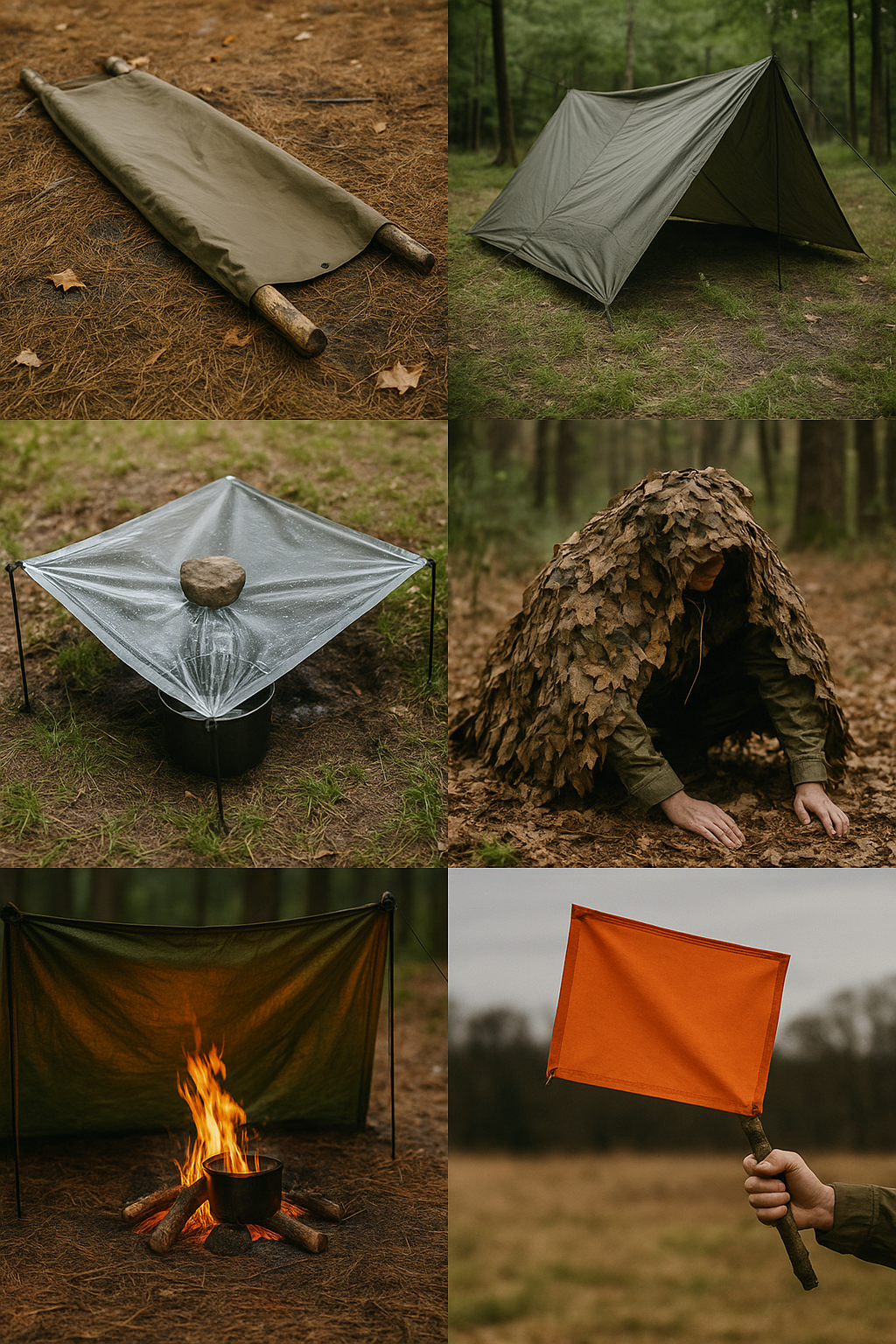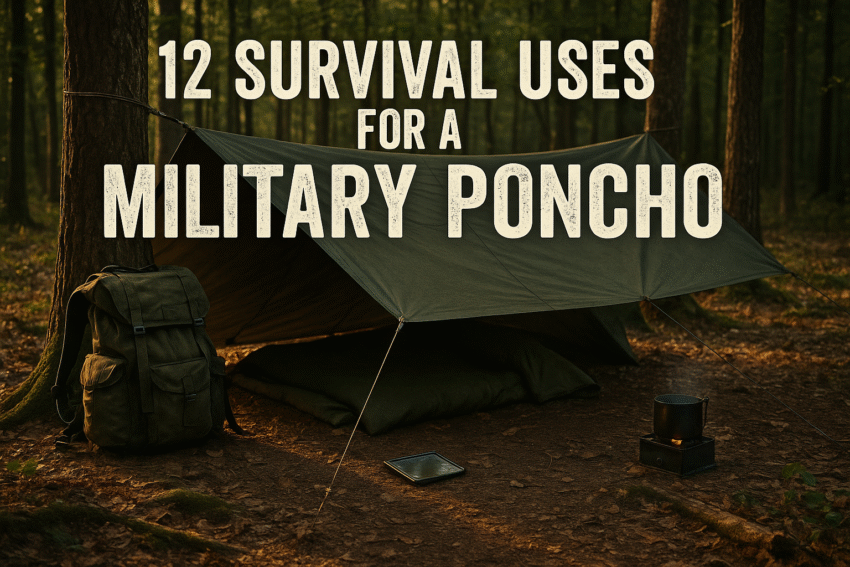1. Shelter / A-Frame Tent
The most common and immediately lifesaving use: rig the poncho between two anchor points with cordage to form an A-frame. Use grommets and paracord to tension it, stake or weigh down the corners, and create a dry, wind-sheltered space.
Add insulation on the floor (wool blanket, leaves, gear) to trap heat. Angle the front slightly forward to create a drip edge so rain runs off without pooling.
2. Improvised Stretcher / Evac Litter
Fold or lash the poncho into a cradle, then insert two strong poles (branches, tent poles) along its sides to carry an injured person. Reinforce corners with paracord and double-wrap for strength.
If poles aren’t available, tie corners together and drag gently as a drag sheet—better than nothing for short-distance movement.
3. Water Collection (Solar Still / Rain Catch)
Use the poncho to collect water in two ways: as a rain catchment surface or part of a solar still. For rain, angle the poncho so water funnels into a container or cup.
For a solar still, dig a shallow pit, place green vegetation in the center, cover the pit with the poncho, and weight the center slightly to create a low point. Condensation will form on the underside and drip into a collection vessel.
Always purify unless using condensation collection directly.
4. Camouflage & Concealment
Drape the poncho over gear, shelters, or movement routes to break up outlines and reduce visibility. Weave local foliage through grommets or drape the underside outward in low light to mask reflections. A poncho over a small hide site or cache blends natural and artificial textures quickly.

5. Emergency Rainwear / Cloak
Use the poncho as intended: rain and wind protection. Wrap it over the shoulders or fashion a hood with snap points or knots. It can also serve as a windbreaker in cold weather when layered over base clothing. Secure with cordage or tie-downs so it doesn’t flap off in gusts.
6. Ground Sheet / Moisture Barrier
Place the poncho beneath your sleeping system to isolate from damp or cold ground. Fold it for extra thickness or double-layer in wet conditions. It keeps insulating layers dry and prevents heat loss through direct contact with the earth.
7. Signal Flag / Distress Panel
Flip a corner outward, attach a bright cloth or reflective patch, and wave as a visual signal. Lay it flat on contrasting terrain to mark location for aerial rescue, or raise it on a pole with a whistle and mirror for multi-modal alerting. Combining it with fire/smoke increases detectability.
8. Windbreak / Cooking Shield
Stand the poncho vertically between stakes, branches, or rocks to block wind when cooking or boiling water. This shields flame efficiency and prevents fuel waste. It also works as a temporary privacy screen, protecting operations from observation.
9. Improvised Hauler / Compression Sack
Gather the corners, secure with cordage, and use the poncho as a makeshift sack for firewood, forage, or gear. It can also double as a compression wrap around other items to reduce bulk in packs. Reinforce load points with extra binding if carrying heavier loads.
10. Sun Shade / Heat Reduction
Rig the poncho overhead in hot climates to create shaded space and reduce direct solar exposure. Elevate slightly to allow airflow underneath; combine with a shallow dug trench or reflective ground surface to passively cool the area beneath.
11. Cache Cover / Gear Protection
Cover hidden supplies with the poncho, then layer natural debris over it to disguise caches. Its waterproofing protects contents from light rain when secured correctly. Use it as a base layer to keep gear off wet or dirty ground and then conceal everything with camouflage.
12. Waterproof Wrap / Emergency Kit Cover
Wrap sensitive items—maps, fire-starting kits, radios, medical supplies—in the poncho to keep them dry. Fold tightly and secure with cordage or tuck under larger gear for quick protection during sudden weather shifts. In a heavier storm, pull the poncho over a full pack for rapid waterproofing.
See my 25 Top Military Surplus Survival Items
Layered Combos & Multipliers
Some of the most effective patterns come from combining uses:
- Poncho + Paracord + Wool Blanket: Insulated, concealed shelter with rain protection and thermal layering.
- Poncho Stretcher + Signal Flag: Evacuate injured while simultaneously marking extraction routes.
- Rain Collection Roof: Use the poncho as a shelter roof that funnels water into collection while keeping equipment dry beneath.
Minimal Accessories That Amplify Utility
The poncho works solo, but with a few small additions its flexibility explodes:
- Paracord or similar cordage for rigging and lashings
- Stakes, rocks, or natural anchors for tensioning
- Small bright cloth or reflective material for signaling
- Compression straps when used as a haul sack
Integration into Common Loadouts
Bug-Out Bag
Kept folded, the poncho serves as multipurpose shelter, ground sheet, carry bag, and weather protection without taking significant space. It should be immediately accessible near the top or outer compartment.
Cold Weather Retreat
Layered beneath the sleep system for moisture control, used outside the entrance as a windbreak or extra insulation, and as a makeshift stretcher in case of injury during movement in snow or ice.
Urban Evacuation
Used covertly to conceal gear or movement, fashion a quick litter, or signal extraction points. A marked corner can help collaborators identify safe collection zones without loud signals.
Quick Reference: Poncho Priority Uses by Scenario
| Scenario | Primary Poncho Functions |
|---|---|
| Rain/Storm | Shelter, waterproof wrap, ground sheet |
| Injury Evac | Improvised stretcher, signaling |
| Water Scarcity | Solar still, rain catchment |
| Concealment | Camouflage cover, cache protection |
| Heat / Sun | Shade, passive cooling |
Field Tips & Common Mistakes
- Don’t leave a poncho loosely draped in wind—secure all corners or it becomes noise and exposes position.
- Always test shelter rigging before nightfall; failing over cold terrain costs more than time spent practicing.
- Use natural anchors when possible; over-reliance on single synthetic tie points can fail under load.
- Keep the interior clean if used as stretcher—debris can exacerbate injuries or infect wounds.
- Mark one corner subtly for rescue recognition without compromising low-profile concealment.
FAQ
Are military surplus items legal to own?
In most countries, yes — but restrictions exist. Body armor, certain chemical detection gear, and communication radios may require permits. Check local laws before bulk purchasing or importing.
How do I clean and maintain a surplus gas mask?
Disassemble if possible, wipe the interior with alcohol wipes, replace expired filters, and store in airtight containers with desiccant. Never use petroleum-based solvents on seals, and routinely test the seal integrity before relying on it.
Can I drink from a jerry can used for fuel?
No. Only repurpose a jerry can for water after a full decontamination process: scrub thoroughly with detergent, rinse multiple times, boil water inside, and then dedicate separate containers moving forward to avoid cross-contamination between fuel and drinking water.
What’s the shelf life of modular sleep system components?
If stored dry and periodically inspected/rotated, the sleep system can last 10+ years. Check fabric integrity, compression loss, insulation settling, and waterproofing every 1–2 years to ensure continued performance.
Should I mix surplus with modern gear?
Yes. Hybrid loadouts often outperform purist approaches. Use surplus for durability, redundancy, and core functions, while supplementing with modern lightweight or comfort-oriented pieces where weight and ergonomics matter.
